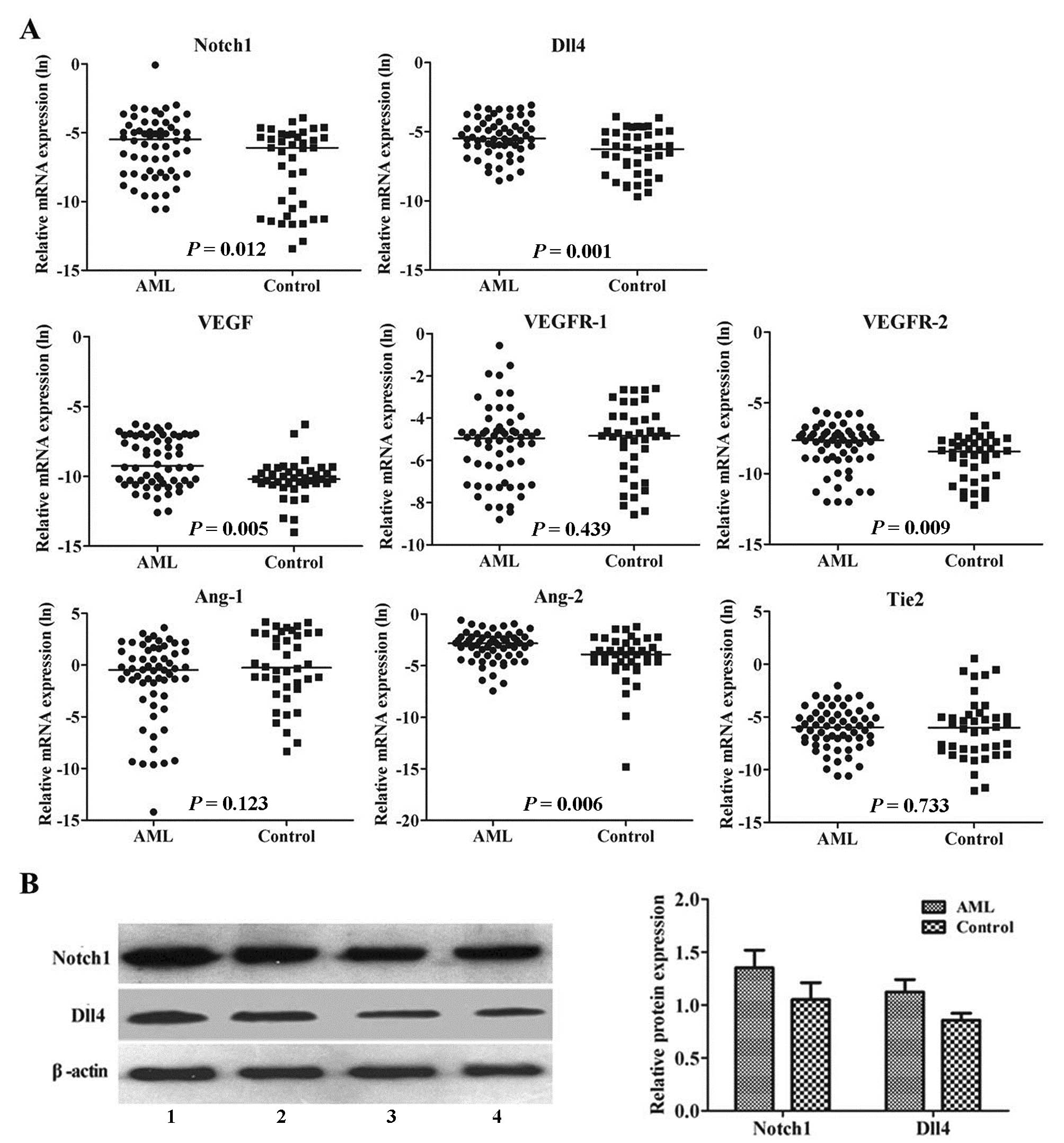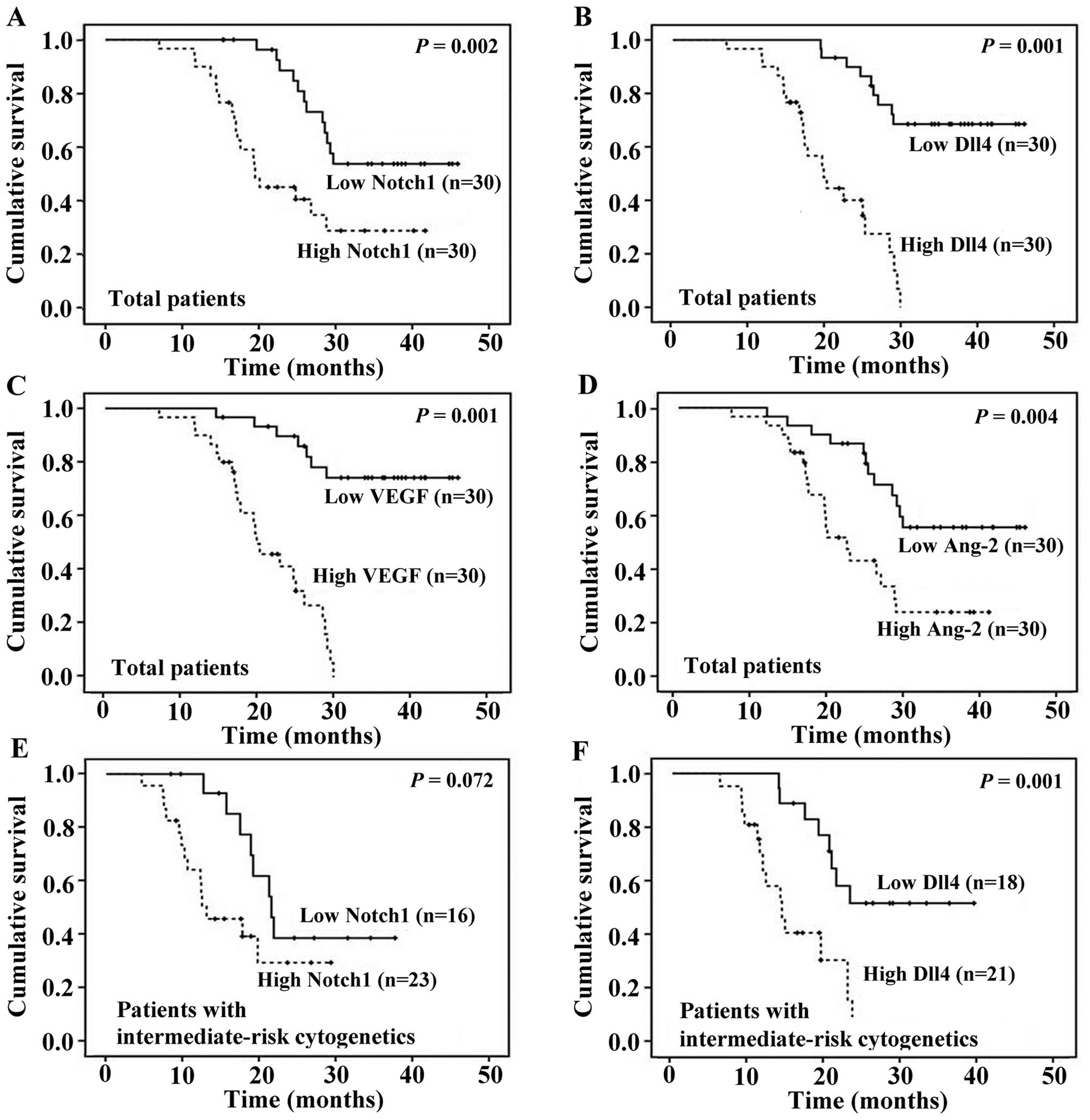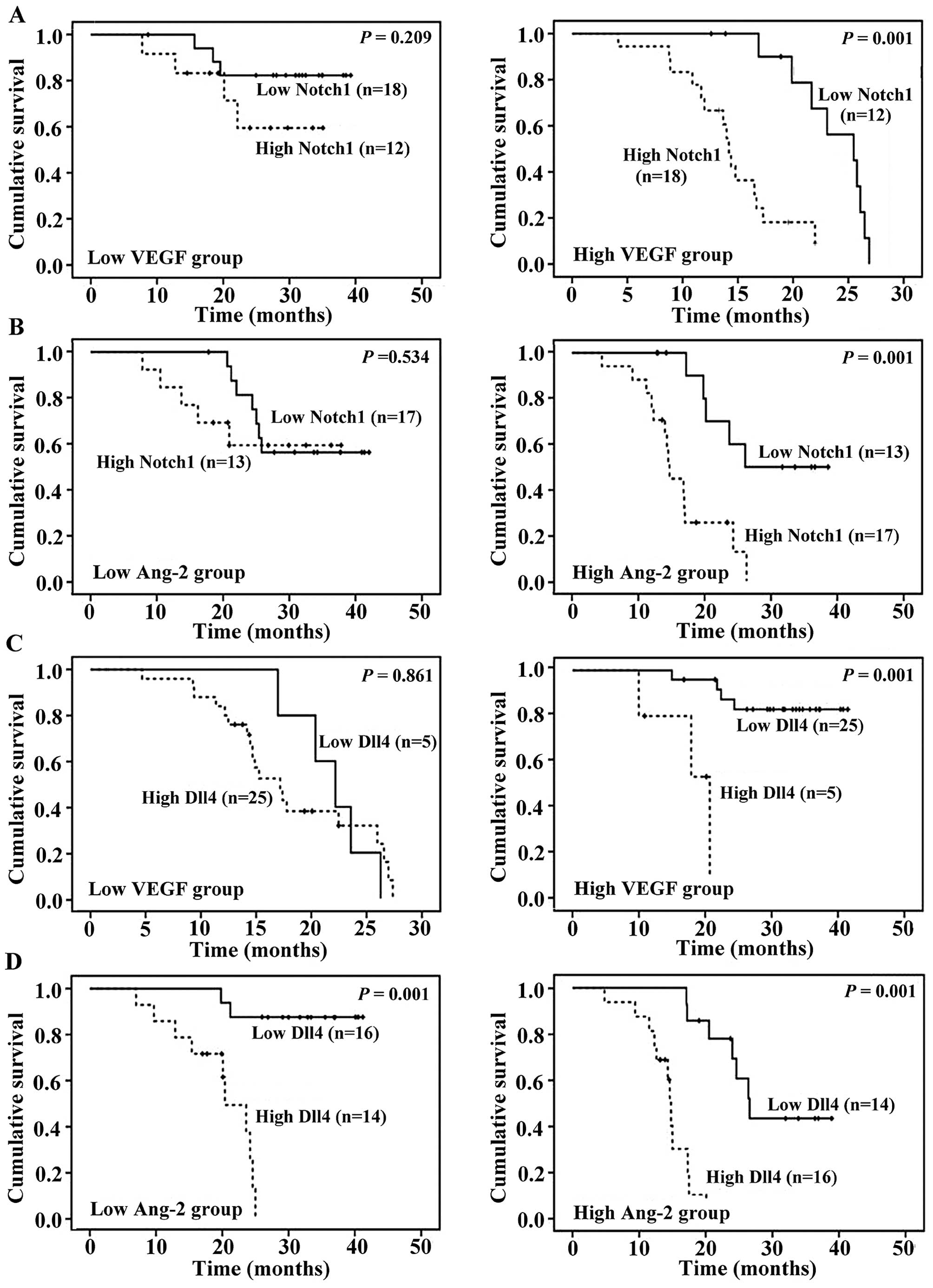|
1
|
Zhang Y, Tang H, Cai J, et al: Ovarian
cancer-associated fibroblasts contribute to epithelial ovarian
carcinoma metastasis by promoting angiogenesis, lymphangiogenesis
and tumor cell invasion. Cancer Lett. 303:47–55. 2011. View Article : Google Scholar
|
|
2
|
Hao CY: Angiogenesis blockade as therapy
for hepatocellular carcinoma: progress and challenges. J
Gastroenterol Hepatol. 26:4–6. 2011. View Article : Google Scholar : PubMed/NCBI
|
|
3
|
Shih TT, Hou HA, Liu CY, et al: Bone
marrow angiogenesis magnetic resonance imaging in patients with
acute myeloid leukemia: peak enhancement ratio is an independent
predictor for overall survival. Blood. 113:3161–3167. 2009.
View Article : Google Scholar
|
|
4
|
Trujillo A, McGee C and Cogle CR:
Angiogenesis in acute myeloid leukemia and opportunities for novel
therapies. J Oncol. 2012:1286082012. View Article : Google Scholar : PubMed/NCBI
|
|
5
|
Payne SJ and Jones L: Influence of the
tumor microenvironment on angiogenesis. Future Oncol. 7:395–408.
2011. View Article : Google Scholar : PubMed/NCBI
|
|
6
|
Ayala F, Dewar R, Kieran M and Kalluri R:
Contribution of bone microenvironment to leukemogenesis and
leukemia progression. Leukemia. 23:2233–2241. 2009. View Article : Google Scholar : PubMed/NCBI
|
|
7
|
Hou HA, Chou WC, Lin LI, et al: Expression
of angiopoietins and vascular endothelial growth factors and their
clinical significance in acute myeloid leukemia. Leuk Res.
32:904–912. 2008. View Article : Google Scholar : PubMed/NCBI
|
|
8
|
Carmeliet P and Jain RK: Molecular
mechanisms and clinical applications of angiogenesis. Nature.
473:298–307. 2011. View Article : Google Scholar : PubMed/NCBI
|
|
9
|
Wegiel B, Ekberg J, Talasila KM, Jalili S
and Persson JL: The role of VEGF and a functional link between VEGF
and p27Kip1 in acute myeloid leukemia. Leukemia.
23:251–261. 2009. View Article : Google Scholar : PubMed/NCBI
|
|
10
|
Schmidt T and Carmeliet P: Angiogenesis: a
target in solid tumors, also in leukemia? Hematology Am Soc Hematol
Educ Program. 2011:1–8. 2011. View Article : Google Scholar : PubMed/NCBI
|
|
11
|
Tait CR and Jones PF: Angiopoietins in
tumours: the angiogenic switch. J Pathol. 204:1–10. 2004.
View Article : Google Scholar : PubMed/NCBI
|
|
12
|
Reikvam H, Hatfield KJ, Lassalle P,
Kittang AO, Ersvaer E and Bruserud O: Targeting the angiopoietin
(Ang)/Tie-2 pathway in the crosstalk between acute myeloid
leukaemia and endothelial cells: studies of Tie-2 blocking
antibodies, exogenous Ang-2 and inhibition of constitutive
agonistic Ang-1 release. Expert Opin Investig Drugs. 19:169–183.
2010. View Article : Google Scholar
|
|
13
|
Maffei R, Martinelli S, Castelli I, et al:
Increased angiogenesis induced by chronic lymphocytic leukemia B
cells is mediated by leukemia-derived Ang2 and VEGF. Leuk Res.
34:312–321. 2010. View Article : Google Scholar : PubMed/NCBI
|
|
14
|
Keith T, Araki Y, Ohyagi M, et al:
Regulation of angiogenesis in the bone marrow of myelodysplastic
syndromes transforming to overt leukaemia. Br J Haematol.
137:206–215. 2007. View Article : Google Scholar : PubMed/NCBI
|
|
15
|
Aguayo A, Kantarjian HM, Estey EH, et al:
Plasma vascular endothelial growth factor levels have prognostic
significance in patients with acute myeloid leukemia but not in
patients with myelodysplastic syndromes. Cancer. 95:1923–1930.
2002. View Article : Google Scholar
|
|
16
|
de Bont ES, Fidler V, Meeuwsen T, Scherpen
F, Hahlen K and Kamps WA: Vascular endothelial growth factor
secretion is an independent prognostic factor for relapse-free
survival in pediatric acute myeloid leukemia patients. Clin Cancer
Res. 8:2856–2861. 2002.PubMed/NCBI
|
|
17
|
Loges S, Heil G, Bruweleit M, et al:
Analysis of concerted expression of angiogenic growth factors in
acute myeloid leukemia: expression of angiopoietin-2 represents an
independent prognostic factor for overall survival. J Clin Oncol.
23:1109–1117. 2005. View Article : Google Scholar
|
|
18
|
Schliemann C, Bieker R, Thoennissen N, et
al: Circulating angiopoietin-2 is a strong prognostic factor in
acute myeloid leukemia. Leukemia. 21:1901–1906. 2007. View Article : Google Scholar : PubMed/NCBI
|
|
19
|
Wu Y, Cain-Hom C, Choy L, et al:
Therapeutic antibody targeting of individual Notch receptors.
Nature. 464:1052–1057. 2010. View Article : Google Scholar : PubMed/NCBI
|
|
20
|
Demarest RM, Dahmane N and Capobianco AJ:
Notch is oncogenic dominant in T-cell acute lymphoblastic leukemia.
Blood. 117:2901–2909. 2011. View Article : Google Scholar : PubMed/NCBI
|
|
21
|
Leong KG and Karsan A: Recent insights
into the role of Notch signaling in tumorigenesis. Blood.
107:2223–2233. 2006. View Article : Google Scholar : PubMed/NCBI
|
|
22
|
Phng LK and Gerhardt H: Angiogenesis: a
team effort coordinated by notch. Dev Cell. 16:196–208. 2009.
View Article : Google Scholar : PubMed/NCBI
|
|
23
|
Li JL and Harris AL: Notch signaling from
tumor cells: a new mechanism of angiogenesis. Cancer Cell. 8:1–3.
2005. View Article : Google Scholar : PubMed/NCBI
|
|
24
|
Ridgway J, Zhang G, Wu Y, et al:
Inhibition of Dll4 signalling inhibits tumour growth by
deregulating angiogenesis. Nature. 444:1083–1087. 2006. View Article : Google Scholar : PubMed/NCBI
|
|
25
|
Noguera-Troise I, Daly C, Papadopoulos NJ,
et al: Blockade of Dll4 inhibits tumour growth by promoting
non-productive angiogenesis. Nature. 444:1032–1037. 2006.
View Article : Google Scholar : PubMed/NCBI
|
|
26
|
Lobry C, Oh P and Aifantis I: Oncogenic
and tumor suppressor functions of Notch in cancer: it's NOTCH what
you think. J Exp Med. 208:1931–1935. 2011. View Article : Google Scholar
|
|
27
|
Lobov IB, Brooks PC and Lang RA:
Angiopoietin-2 displays VEGF-dependent modulation of capillary
structure and endothelial cell survival in vivo. Proc Natl Acad Sci
USA. 99:11205–11210. 2002. View Article : Google Scholar : PubMed/NCBI
|
|
28
|
Li JL and Harris AL: Crosstalk of VEGF and
Notch pathways in tumour angiogenesis: therapeutic implications.
Front Biosci. 14:3094–3110. 2009.PubMed/NCBI
|
|
29
|
Thurston G and Kitajewski J: VEGF and
Delta-Notch: interacting signalling pathways in tumour
angiogenesis. Br J Cancer. 99:1204–1209. 2008. View Article : Google Scholar : PubMed/NCBI
|
|
30
|
Morrow D, Cullen JP, Cahill PA and Redmond
EM: Ethanol stimulates endothelial cell angiogenic activity via a
Notch- and angiopoietin-1-dependent pathway. Cardiovasc Res.
79:313–321. 2008. View Article : Google Scholar : PubMed/NCBI
|
|
31
|
Zhang J, Fukuhara S, Sako K, et al:
Angiopoietin-1/Tie2 signal augments basal Notch signal controlling
vascular quiescence by inducing delta-like 4 expression through
AKT-mediated activation of beta-catenin. J Biol Chem.
286:8055–8066. 2011. View Article : Google Scholar
|
|
32
|
Kittang AO, Hatfield K, Sand K, Reikvam H
and Bruserud O: The chemokine network in acute myelogenous
leukemia: molecular mechanisms involved in leukemogenesis and
therapeutic implications. Curr Top Microbiol Immunol. 341:149–172.
2010.PubMed/NCBI
|
|
33
|
Muller-Berndorff H, Haas PS, Kunzmann R,
Schulte-Monting J and Lubbert M: Comparison of five prognostic
scoring systems, the French-American-British (FAB) and World Health
Organization (WHO) classifications in patients with myelodysplastic
syndromes: Results of a single-center analysis. Ann Hematol.
85:502–513. 2006. View Article : Google Scholar
|
|
34
|
Ji M, Li J, Yu H, et al: Simultaneous
targeting of MCL1 and ABCB1 as a novel strategy to overcome drug
resistance in human leukaemia. Br J Haematol. 145:648–656. 2009.
View Article : Google Scholar : PubMed/NCBI
|
|
35
|
Lee CY, Tien HF, Hu CY, Chou WC and Lin
LI: Marrow angiogenesis-associated factors as prognostic biomarkers
in patients with acute myelogenous leukaemia. Br J Cancer.
97:877–882. 2007.PubMed/NCBI
|
|
36
|
Ghaleb AM, Aggarwal G, Bialkowska AB,
Nandan MO and Yang VW: Notch inhibits expression of the
Kruppel-like factor 4 tumor suppressor in the intestinal
epithelium. Mol Cancer Res. 6:1920–1927. 2008. View Article : Google Scholar : PubMed/NCBI
|
|
37
|
Li GH, Fan YZ, Liu XW, et al: Notch
signaling maintains proliferation and survival of the HL60 human
promyelocytic leukemia cell line and promotes the phosphorylation
of the Rb protein. Mol Cell Biochem. 340:7–14. 2010. View Article : Google Scholar : PubMed/NCBI
|
|
38
|
Tohda S: Functional analysis of notch in
the pathophysiology of leukemia. Rinsho Byori. 57:351–356. 2009.(In
Japanese).
|
|
39
|
Donnem T, Andersen S, Al-Shibli K, Al-Saad
S, Busund LT and Bremnes RM: Prognostic impact of Notch ligands and
receptors in nonsmall cell lung cancer: coexpression of Notch-1 and
vascular endothelial growth factor-A predicts poor survival.
Cancer. 116:5676–5685. 2010. View Article : Google Scholar : PubMed/NCBI
|
|
40
|
Reedijk M, Odorcic S, Chang L, et al:
High-level coexpression of JAG1 and NOTCH1 is observed in human
breast cancer and is associated with poor overall survival. Cancer
Res. 65:8530–8537. 2005. View Article : Google Scholar : PubMed/NCBI
|
|
41
|
Shi TP, Xu H, Wei JF, et al: Association
of low expression of notch-1 and jagged-1 in human papillary
bladder cancer and shorter survival. J Urol. 180:361–366. 2008.
View Article : Google Scholar : PubMed/NCBI
|
|
42
|
Siekmann AF, Covassin L and Lawson ND:
Modulation of VEGF signalling output by the Notch pathway.
Bioessays. 30:303–313. 2008. View Article : Google Scholar : PubMed/NCBI
|
|
43
|
Williams CK, Li JL, Murga M, Harris AL and
Tosato G: Up-regulation of the Notch ligand Delta-like 4 inhibits
VEGF-induced endothelial cell function. Blood. 107:931–939. 2006.
View Article : Google Scholar : PubMed/NCBI
|
|
44
|
Wakabayashi M, Miwa H, Shikami M, et al:
Autocrine pathway of angiopoietins-Tie2 system in AML cells:
association with phosphatidyl-inositol 3 kinase. Hematol J.
5:353–360. 2004. View Article : Google Scholar : PubMed/NCBI
|
|
45
|
Xu Q, Simpson SE, Scialla TJ, Bagg A and
Carroll M: Survival of acute myeloid leukemia cells requires PI3
kinase activation. Blood. 102:972–980. 2003. View Article : Google Scholar : PubMed/NCBI
|












